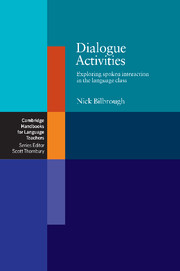Book contents
- Frontmatter
- Contents
- Thanks and acknowledgements
- Introduction
- 1 Understanding
- 2 Analysing
- 3 Reproducing and reconstructing
- 4 Memorising
- 5 Rehearsing and performing
- 6 Co-constructing
- 7 Creating and personalising
- 8 Communicating
- 9 Dialogue as learning
- Dialogue Bank A From the film Mulholland Drive
- Dialogue Bank B Authentic snippets
- Dialogue Bank C Snippets from fairy tales
- Dialogue Bank D Lame jokes
- Dialogue Bank E Situational dialogues
- Dialogue Bank F ‘Dating Agency’ from the comedy series Little Britain
- Further reading and resources
- Index
5 - Rehearsing and performing
Published online by Cambridge University Press: 06 July 2010
- Frontmatter
- Contents
- Thanks and acknowledgements
- Introduction
- 1 Understanding
- 2 Analysing
- 3 Reproducing and reconstructing
- 4 Memorising
- 5 Rehearsing and performing
- 6 Co-constructing
- 7 Creating and personalising
- 8 Communicating
- 9 Dialogue as learning
- Dialogue Bank A From the film Mulholland Drive
- Dialogue Bank B Authentic snippets
- Dialogue Bank C Snippets from fairy tales
- Dialogue Bank D Lame jokes
- Dialogue Bank E Situational dialogues
- Dialogue Bank F ‘Dating Agency’ from the comedy series Little Britain
- Further reading and resources
- Index
Summary
All real-life language use is a form of performance. Indeed, the term performance is often used by linguists to describe what we do with language, as opposed to what we know about language (called competence). In another sense, too, we use language to perform ourselves – to make public our own unique identity. We do this by using a common language and making it our own. We take other people's words and we recycle them for our own situation-specific purposes. In this sense, language production is an endless process of borrowing, adapting, rehearsing and performing.
The activities in this section ask the learners to work with texts which have already been planned and constructed by others. In the same way that actors are generally not expected to write great works of literature whilst they are simultaneously performing on stage, the learners here, free from the pressure of having to create language in real time, are able to focus on other issues surrounding the dialogues. These issues may include different ways of pronouncing and interpreting the lines, as well as strategies for making what they say more interesting for the listeners. The learners are also provided with the opportunity to rehearse and practise the dialogues a number of times, each time increasing their familiarity with the content.
- Type
- Chapter
- Information
- Dialogue ActivitiesExploring Spoken Interaction in the Language Class, pp. 107 - 133Publisher: Cambridge University PressPrint publication year: 2007



